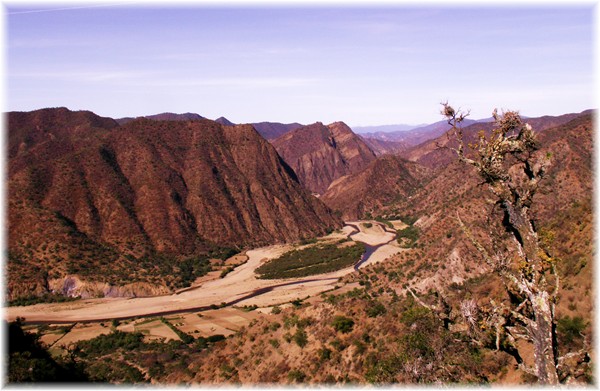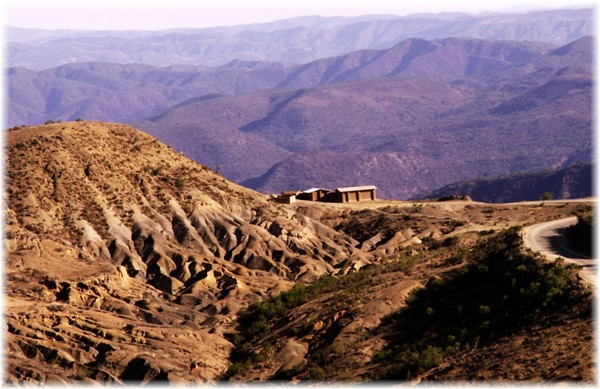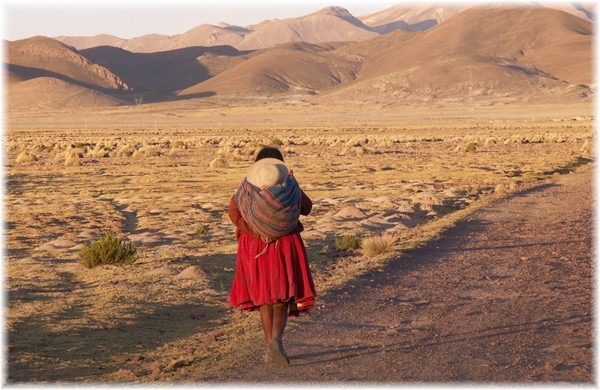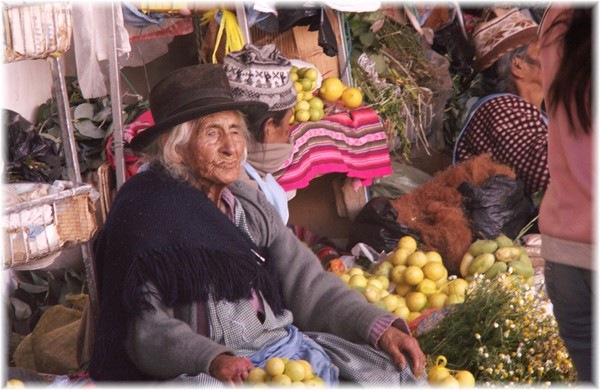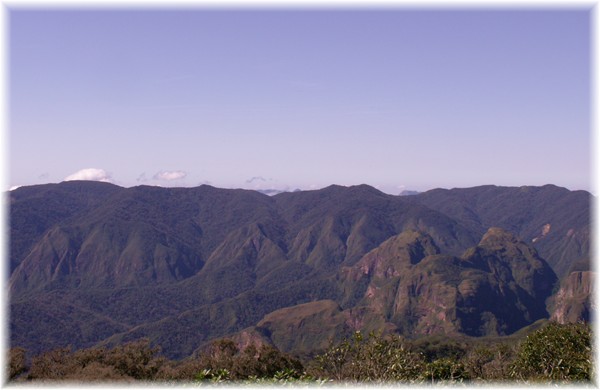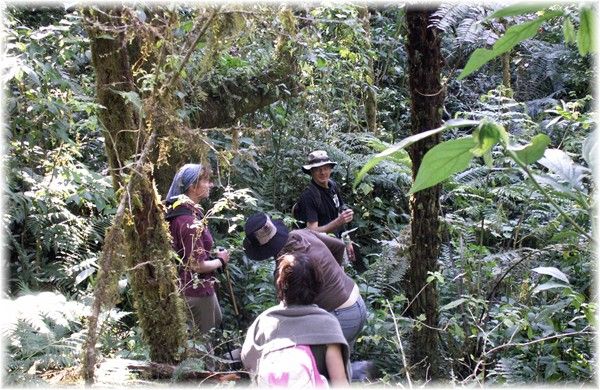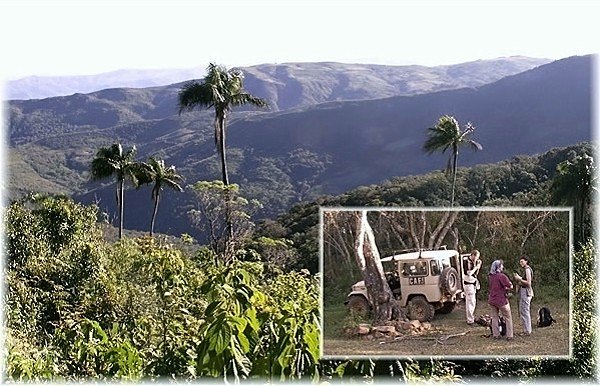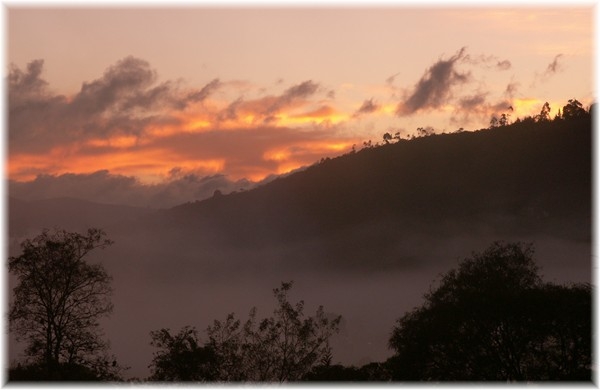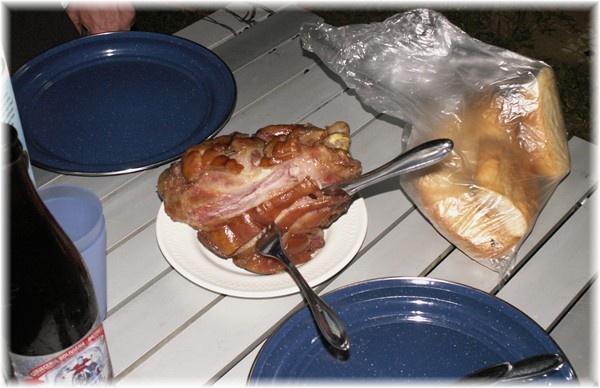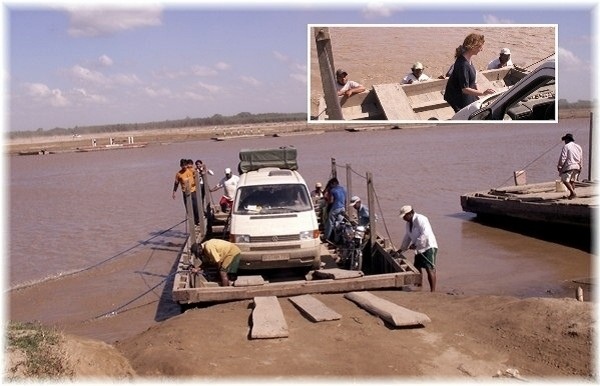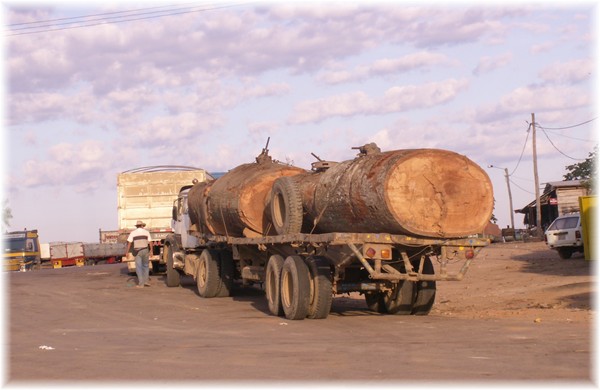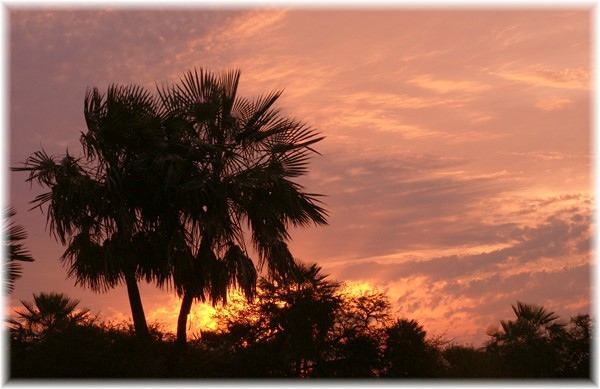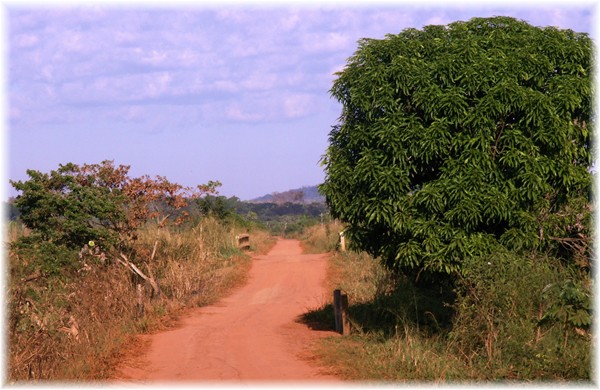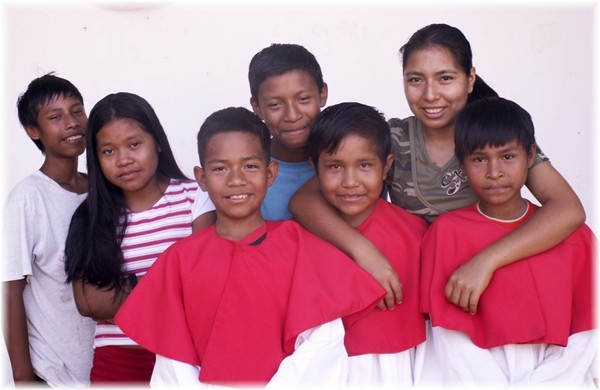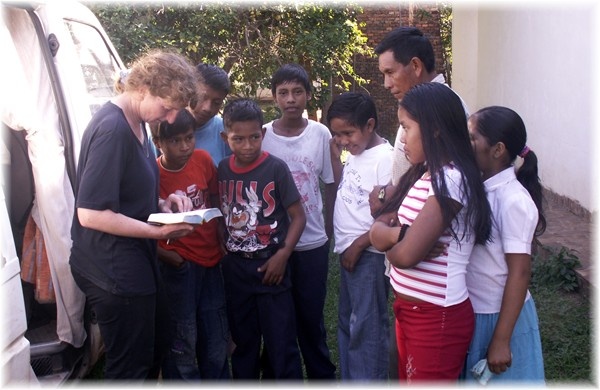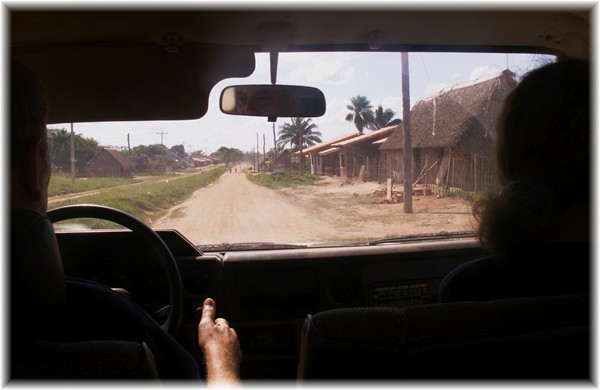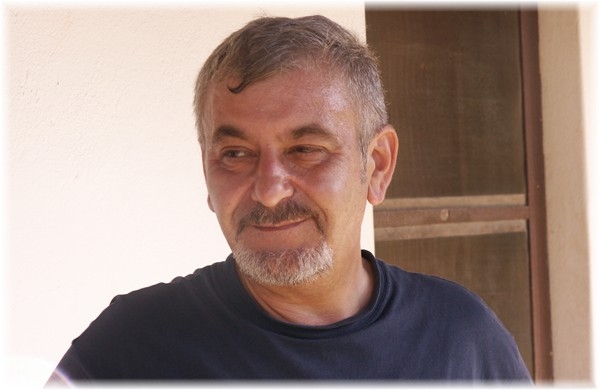Anna and Victor, the owner of the hostel, made it quiet difficult for us to leave this wonderful place. As a good bye present they gave us a little figure: Pachamama, the goddess of the Inkas for a save further on journey. Nowhere else in South America we felt so much home as we did here in Sucre, at the Pachamama hostel and that was the reason that we did stay such a long time.
But even so, after 18 days here, it is time to get to know more about the rest of the world. Our way leads us further on through the highlands of Bolivia. The first few kilometres after Sucre are still asphalt, then it is gravel road. First through a wonderful mountain range till the way is then leading along the riverbed.
Very often, half of the street is gone down the slope. In front of us there are some trucks standing in line. We have to stop, what is the matter? Caterpillars remove the rocks, stones and gravel which are lying on the street. Last night there was a rock fall. We are lucky, after half an hour we can continue. But the street is getting worse, for the last 60 km we needed three hours. Well, but on the other hand, we see the landscape much more intensively.
Now we know, why the streets in Boliva are as bad. The population of Bolivia don’t care about the streets, since they anyway can’t afford to own a car. There are just a few on the streets, most are trucks or overland buses and they drive predominant during the night.
We drive along farm houses, which are miles and miles away from each other. Rarely that we can find villages. This landscape reminds us to the advertisement for coffee, which years ago have been on German TV.
A young farmer installs a box for the energy-counter. In the next days he will receive electricity for his house. His two baby kids are running round the house, dressed only with a T-Shirt and underwear and this after all, that the sunset is already 20 minutes ago and for our opinion it is ice-cold. We are still on an altitude of 3500 m. The young farmer give us permission to overnight on his piece of land. It spreads like wildfire “ two strangers with a small transporter have been landing here on the Altiplano” All kids from the near district have made their way and observe us from a secure distance. In the early morning before sunrise we can already hear them in front of our bus. In that moment we open the door, they are all gone with the wind.
Next where we stood with our bus, there is the place to thresh wheat. Together with the neighbours they still do the work by hand like hundred years earlier in Europe. It is Sunday morning, 8.00 o’clock and both of the nearby neighbours come to the threshing place for work. Unfortunately we have to go further, since we still have a long long way in front of us. Our destiny for today is Samaipata. For a while the street leads us above the fog and we are like floating on clouds.
The fog comes from the rainforest of the lowlands up to the ridge of the Cordillera Oriental only to “lay down” in the valleys of the highlands. Later on the way leads us down again and now we are in the midst of the fog. Five hours of drive through fog on roads which nobody in Europe would call a road so much of mud on it. Very often the street is as wide as one car and the slope is vertical next to the street.
We think it over: should we continue or just pull aside and wait? But what if it rains even more? Can we then continue or could it be that we get stacked in the mud? Lot’s of questions are in our head. What is the right thing to do? We decide to continue. Whenever it works, we stop for a short time just to clean the dipped headlights, to make sure that other cars and trucks can see us. The few trucks which passes us, are mostly without lights or just one working. Now we understand, to drive in Bolivia is not just adventure it can get very dangerous. It is already afternoon when the fog clears. How great it feels for the eyes. We only have now 30 km in front of us till we reach Comarapa and there the asphalt starts again. The leftover 120 km till Samaipata are easy to do.
In Samaipata we stay a few days on the campground of Pieter and Margarita. They are originally from the Netherlands but already 20 years living in Bolivia. They not just have a campground as well a herbal farm with medicinal herbs.
Before we will leave the Altiplano we want to do a daytrip through the fog forest of the mountains.
For this hiking tour we need a guide (it is not allowed to do hikes without one), to make sure we come back safely. Pieter is organizing this tour and calls up a friend of him, Frank, who lives here in Samaipata since seven years; before he moved over to Bolivia, he worked in a bank in Hamburg.
Next morning, Frank picks us up with his jeep. Heidi and Sonja from Erlangen, Germany are joining the tour. Heidi the mother of Sonja, is on a vacation here in Bolivia to see where exactly her daughter works in the jungle. Sonja works as a volunteer down in the rainforest in a small village as a nursery school teacher.
After one hour drive we are somewhere in the jungle. From now on we have to go on foot. Frank leads us through and certainly have a bush knife with him.
The peculiarity of this mountain fog-forest are the huge ferns. On our way to the edge we pass different zones of vegetation. Up on the peek we have a terrific 360° panorama over the other peeks of the mountain range and as well down to the ferns. On normal conditions you have lots of fog around you, seldom enough that there is no fog. Well, we are lucky and have one of this very seldom days without fog. Animal wise we do not see more then different kind of beautiful butterflies and parrots. On our way back, Frank shows us a fresh footprint of a Jaguar, which is even for him a highlight, since even the footprints of a Jaguar are very seldom to see. After six hours of walking we are back at the jeep and start our way towards Samaipata again.
Over six weeks we have been up here on the Altiplano. Our next destination is the area of the missions from the Bavarian Franziskaner in South-Amazonian. For this stretch of 480 km we guess that we need about two days of travel, since most of the stretches are asphalt, according to our street map. In the end we need more than that, since again the street card of Bolivia is not right.
In the early morning we continue our travel. On our way, we first stock up our fruit and vegetable store, with one of the farmers selling there harvest here. The first two hours we continuously drive downwards and arrive the suburbs of Santa Cruz, which is a town with over a million inhabitants. Normally we try to avoid driving through big cities like this, but in this case there is no other way leading around the town. A few times we loose our way and again we have to ask for the way up to the North a thousand times. Here as well then in the rest of Bolivia you hardly can find street signs, which tell you where to go. It is already late afternoon as we recognize outside of Santa Cruz a sign showing “Delicatessen of Austria – 300 m”. We want to know what this is all about and follow the sign onto a cattle farm. The dog of the farm already greets us, but other then him nobody seems to be at home. We ring the bell, we shout out, nobody shows up. In that moment we think about leaving again, Elfriede comes out of the cowshed. We ask if we can buy some of the delicacies of Austria. Certainly, she shouts out and tell us how it have been, as she together with her husband Andreas and there three kids have been moving over to Bolivia to settle down. Since a few years they have as well a small restaurant, where Elfriede cooks on Saturday and Sundays specialities of Austria, certainly with there own meat. The most favourite meal for the Bolivians is Surhaxn (roasted pork leg) with Sauerkraut Elfriede invites us for coffee and cake (self-made certainly) and tells us that originally she is from the Rhineland Palatinate but been already a widow at a age of 21. Then she met Andreas from Austria and did move with him over to Bolivia. In that moment Andreas enter the restaurant and says: “If you want, you can stay with your bus on our ground” Sure we love to do that and as well we are definitely not cooking tonight, we have Surhaxen (roasted pork leg) for dinner.
Later in the evening Andreas comes to us and we sit together. Now we hear the whole story of his life which is truly interesting. He is already over 70 years old and still working on the farm. Time is running and the next look onto our watch shows already midnight.
Next day we drive further. The street gets a nightmare again, since it is not looking at all like a street for over 10 km. In the end the “street” ends in the dry riverbed of the Rio Grande. Now, in the moment the Rio Grande is just 200 m wide but during rainy season it is over a thousand meters wide. To cross the 200 m river we need to go on a wooden panel. It is quiet shaky till we are on the barrage?? Four men are pushing with their hands the barrage over to the other side.
On the other side of the river we see a small hat, where they sell grilled river fish. We take a break and eat fish, rice and yucca for lunch. We invite a young priest for lunch who showed us with his motorbike the way through the riverbed. Then we continue our way on the bumpy gravel road. The heat and the humidity is even harder to stand then the coldness which we had in the last weeks up at the Altiplano. Well not really the heat gives us a problem but the humidity. On top of it, there are lots of mosquitoes and bugs, which in our whole life we have not seen until now. Especially at sunset and sunrise they try to come into our small house and make us mad. We realize we are coming to the real jungle. Trucks are often passing us with the load of huge trees from the rainforest.
For today the sun did already say goodbye. To our destination, Urubicha, there are still 50 km to go. Since we don’t know the way, we decide to overnight here. We ask the boss of the nearby jungle airport, if we can overnight here on this ground. Certainly!
Next day, shortly after sunrise we continue. From the town Ascencion we have to drive over red soil for about 40 km in the direction North-East. Many termite hills are along the street. If the lots of palm trees would not be here, one could think we are in Australia. It is Sunday morning, shortly before 9 o´clock. In that moment we are at the village square, the people come out from church mass.
Father Walter, a monk of the Franziskaner order, who lives here at the Rio Blanco already forty years, did reanimate an old tradition. He brought back the music to the Ciquitanos, how the Indio’s here in Urubicha are called. The Jesuit order, which have been here already 300 years ago, taught the Indios how to play European music instruments. After the order have been banned, the Indios did go back into the jungle again. A few years ago, Father Walter tried again, to teach the Ciquitanos how to play and even the way of producing the instruments – which was a long tradition of the Indios – he brought back.
Eleven years ago, he founded together with Sister Ludmila a music school, where the youngsters have now the possibility to play the different instruments. Classical music was not very well known here in Bolivia but know the Indios play the baroque style. Last year the choir and the orchestra of Urubicha have been invited by Adveniat, to do a tour in Germany in different cities. Sister Ludmila tells us, that the children can choose between eleven music instruments and the goal is, to even establish a music high school with boarding school. As well this year in November and December they will go on a concert tour through Germany.
Father Walter invites us to stay here at the mission for a few days and even to stay in on of there guestrooms. The room where we are sleeping is still original from the colonial time. We feel like in a monastery. The walls of the rooms are over one meter thick and the ceiling is over four meter up. The room itself is laid out very simple, we can choose between a bed and a hammock.
The mission is constructed in a square. At the front side there stands the church. Around the church on the side is the weaving mill, a carpenters workshop and a carving workshop. The hospital, the school, the nursery, the cattle farm and the music school is a bit further away. As well a small shop is here, where all the self-made products are sold.
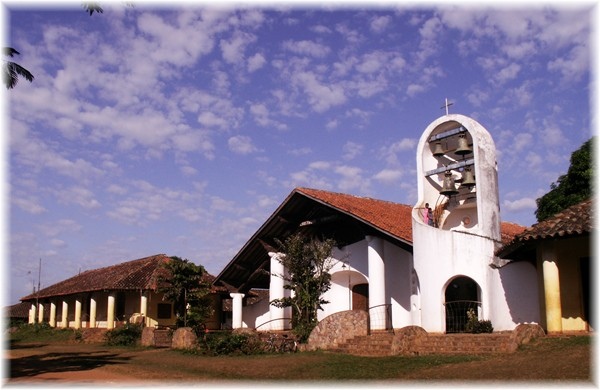
... the church of the Franziskaner order of Urubicha, left hand side the building for the mission from the old colonial time (where we live)
We have a small surprise for Father Walter. My uncle, which actually had the idea, that we could visit the mission, gave us pictures from the time when he have been in the seminar for priests in the year 1950. Father Walter have been at the same time in the seminar for priests and so there are lots of priests which he know as well. In that moment he looks at the pictures he goes back in his thoughts to that time and tells us lots of stories which have happened.

... Father Walter Neuwirth, born in the Bohemian forest as the youngest of ten kids, lives since 40 years here in Urubicha
Together with him and Sister Ludmila we sit together on that evening and laugh a lot about the stories which they tell us of the old times.
As well Father Walter have a surprise for us. He tells us, that in the next mission, about 40 km away from Urubicha, is Father Franz, who originally comes from Schwandorf. Schwandorf is the neighbouring town from where I come from. “Father Franz will be very happy to see you, tomorrow morning I will call him and tell, that you are coming for lunch” say Father Walter. This is a great idea and we already look forward for tomorrow.
After breakfast we drive to Yaguaru. Again we have to go on dusty streets through the jungle. We are happy that we are here during dry season. In the rainy season we could not do this stretch with our bus. The village, for which Father Franz is the pastor for the last 2 ½ years, is called Yaguaru. Shortly before lunchtime we reach the mission. He tells us his life and about his work here in the village. After lunch we drive with his jeep through the village and he shows us what have changed since he is here.
„Not a single moment I had the feeling that I am bored” For whatever he does, he first have to arrange money. No matter if it is for constructing a house, or a needed operation for someone or for schoolbooks, which most of the people can’t afford. In the short time he is already watching after the village, he did let construct already 60 houses. We could listen to him forever, but Father Franz has still a lot to do.
We thank him, that he took the time for us to show us around. Especially, since in two days he is going on his first vacation for the first time and certainly that means, he still have a lot to organize. On our way back to Urubicha we both are quiet. We over think what we have heard and seen the last couple of days. Certainly not everything was right, what the church did do with their mission all over the world, but people like we met in the last days, do spend their live to make it easier and healthier for the Indio’s. We have no words for this kind of efforts which they give.
For us this days have been most interesting for us here in Urubicha and Yaguaru. We did learn a lot for life, a journey is as well always a journey for the sole.
Our journey takes us further about 250 km east to the village of Concepcion. We want to visit the graveyard of the former bishop Eduard Bösl, who is buried at a side altar in the mission church. Bishop Bösl comes originally from Hirschau, not far away from my hometown Pfreimd and have been here as a bishop in Bolivia till his death in 2000. As we meet the secretary of the bishop and tell her that we would like to visit the graveyard of bishop Bösl, she invites us to sleep in their guesthouse. We tell her, that we would be happy enough to get a place where we could stand with our bus but she just answers “Bishop Bösl would be not happy with this, please accept the invitation”. This is already now our fourth night in a “normal bed” and we nearly get withdrawal symptoms if we think about our bus.
Next day we say good bye to the area where all the missions are situated and go down further South towards Paraguay.
But this is another story.
Raimund and Michaela



